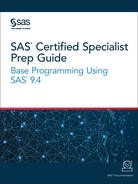Chapter 5: Identifying and Correcting SAS Language Errors
-
Correct answer: aTo correct errors in programs when you use the Editor window, you usually need to recall the submitted statements from the recall buffer to the Editor window. After correcting the errors, you can resubmit the revised program. However, before doing so, it is a good idea to clear the messages from the SAS log so that you do not confuse the old error messages with the new messages. Remember to check the SAS log again to verify that your program ran correctly.
-
Correct answer: dThe missing quotation mark in the LABEL statement causes SAS to misinterpret the statements in the program. When you submit the program, SAS is unable to resolve the PROC step, and a PROC PRINT running message appears at the top of the active window.
-
Correct answer: cSyntax errors generally cause SAS to stop processing the step in which the error occurred. When a program that contains an error is submitted, messages regarding the problem also appear in the SAS log. When a syntax error is detected, the SAS log displays the word ERROR, identifies the possible location of the error, and gives an explanation of the error.
-
Correct answer: cSyntax errors occur because the program statements did not conform to the rules of the SAS language. Syntax errors, such as misspelled keywords, generally prevent SAS from executing the step in which the error occurred.
-
Correct answer: bWhen you submit a SAS statement that contains an invalid option, a log message notifies you that the option is not valid or not recognized. You should recall the program, remove or replace the invalid option, check your statement syntax as needed, and resubmit the corrected program.
-
Correct answer: bThe DATA step contains a misspelled keyword (dat instead of data). However, this is such a common (and easily interpretable) error that SAS produces only a warning message, not an error.
-
Correct answer: dThe _N_ and _ERROR_ temporary variables can be helpful when debugging a DATA step. The _N_ variable displays debugging messages for a specified number of iterations of the DATA step. The _ERROR_ displays debugging messages when an error occurs.
-
Correct answer: dYou can use the PUTLOG statement or the PUT statement to help identify errors and print messages in the SAS log. You can use the PUTLOG statement in a DATA step to write messages to the SAS log to help identify logic errors. You can also use temporary variables in the PUTLOG to assist in debugging. You can use the PUT statement to examine variables and print your own message to the SAS log.
-
Correct answer: cA logic error occurs when the program statements follow the rules and execute, but the results are not correct. You can use the PUTLOG statement in the DATA step to help identify logic errors.
Last updated: February 14, 2019
..................Content has been hidden....................
You can't read the all page of ebook, please click here login for view all page.
